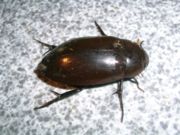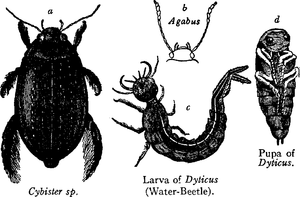
Water beetle
Encyclopedia

Beetle
Coleoptera is an order of insects commonly called beetles. The word "coleoptera" is from the Greek , koleos, "sheath"; and , pteron, "wing", thus "sheathed wing". Coleoptera contains more species than any other order, constituting almost 25% of all known life-forms...
adapted to living in water. Water beetles rise to the water surface and take atmospheric air into their tracheal systems. There are approximately 2000 species of water beetles. The rest marine
Marine (ocean)
Marine is an umbrella term. As an adjective it is usually applicable to things relating to the sea or ocean, such as marine biology, marine ecology and marine geology...
species tend to live in the intertidal zone
Intertidal zone
The intertidal zone is the area that is above water at low tide and under water at high tide . This area can include many different types of habitats, with many types of animals like starfish, sea urchins, and some species of coral...
. Water beetles are black, brown, or greenish and .08 to 1.57 inches long.
Many water beetles carry an air bubble underneath their abdomens, which both provides an air supply, and prevents water from getting into the spiracle
Spiracle
Spiracles are openings on the surface of some animals that usually lead to respiratory systems.-Vertebrates:The spiracle is a small hole behind each eye that opens to the mouth in some fishes. In the primitive jawless fish the first gill opening immediately behind the mouth is essentially similar...
s. Others have the surface of their exoskeleton
Exoskeleton
An exoskeleton is the external skeleton that supports and protects an animal's body, in contrast to the internal skeleton of, for example, a human. In popular usage, some of the larger kinds of exoskeletons are known as "shells". Examples of exoskeleton animals include insects such as grasshoppers...
modified to form a plastron, or "physical gill", which permits direct gas exchange with the water. The hind legs are strong like the grasshoppers except it is not for jumping but for swimming. The wing covers are usually grooved on the female and smooth on the male. They have fringed hind legs with hair adapted for swimming. Adults hibernate in underwater soil during a good portion of the year. Water beetles are attracted to lights at night.
Most families of water beetles have larvae that are also aquatic; many have aquatic larvae and terrestrial adults.

Whirligig beetle
The whirligig beetles are a family of water beetles that normally live on the surface of the water. They get their common name from their habit of swimming rapidly in circles when alarmed, and are also notable for their which can see both above and below water.They are also known for their...
s (Gyrinidae), Haliplidae, Noteridae, Amphizoidae, Dytiscidae
Dytiscidae
Dytiscidae – based on the Greek dytikos , "able to dive" – are the predaceous diving beetles, a family of water beetles. They are about 25 mm long on average, though there is much variation between species. Dytiscus latissimus, the largest, can grow up to 45 mm long...
and Hydroscaphidae
Water beetles belong to the order Coleoptera. True (or diving) beetles make up the family Dytiscidae. Types in which the adults are not necessarily aquatic include Hydrophilidae, Lutrochidae
Lutrochidae
Lutrochidae is a family of water beetles sometimes known as "travertine beetles", since in North America they are common in springs and streams depositing travertine....
, Dryopidae, Elmidae, Eulichadidae, Heteroceridae
Heteroceridae
The Heteroceridae, or variegated mud-loving beetles, are a widespread and relatively common family of beetles. They occur on every continent except for Antarctica....
, Limnichidae, Psephenidae, Ptilodactylidae and Sphaeriusidae. A nickname that people call the water beetle is the water devil. Because of their rapidity, they are also known as water tigers.
See also
- Aquatic insectsAquatic insectsAquatic insects live some portion of their life cycle in the water. They feed in the same ways as other insects. Some diving insects, such as predatory diving beetles, can hunt for food underwater where land-living insects cannot compete.-Breathing:...
- Epler, J. H. 1996. Identification manual for the water beetles of Florida (Coleoptera: Dryopidae, Dytiscidae, Elmidae, Gyrinidae, Haliplidae, Hydraenidae, Hydrophilidae, Noteridae, Psephenidae, Ptilodactylidae, Scirtidae). (PDF, 9.0 MB)

